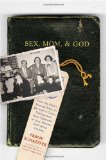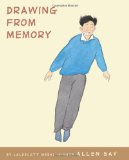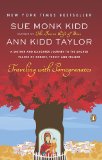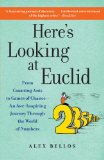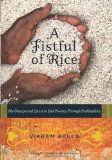 Heaven Is For Real
Heaven Is For Real
A Little Boy’s Astounding Story of His Trip to Heaven and Back
by Todd Burpo
with Lynn Vincent
Thomas Nelson, 2010. 163 pages.
Starred Review
I gobbled up this book in one afternoon. It’s not long, and the story it tells is truly amazing.
My first reaction was that this story would be a hard one for an atheist to explain away. However, I was quickly informed that is not the case. This concerns a little boy’s testimony. As for me, I think his way of talking about it totally rings true, but the fact that he was so young does allow skeptics to propose that he may have been swayed without realizing it.
However, if you do believe in Heaven, this book will encourage you tremendously. And anyone who has suffered a miscarriage, or lost a beloved parent will find themselves incredibly touched.
Colton first gave them a clue that something unusual had happened when they drove to the city where he almost died.
“‘Do you remember the hospital, Colton?’ Sonja asked.
“‘Yes, Mommy, I remember,’ he said. ‘That’s where the angels sang to me.'”
A little while later, they asked him more about it.
“Then he grew serious. ‘Dad, Jesus had the angels sing to me because I was so scared. They made me feel better.’
“Jesus?
“I glanced at Sonja again and saw that her mouth had dropped open. I turned back to Colton. ‘You mean Jesus was there?’
“My little boy nodded as though reporting nothing more remarkable than seeing a ladybug in the front yard. ‘Yeah, Jesus was there.’
“‘Well, where was Jesus?’
Colton looked me right in the eye. ‘I was sitting in Jesus’ lap.'”
That’s in the intro, to give you an idea of what’s in store. Then they tell about their crisis, where it looked like their four-year-old son was really going to die. Appendicitis wasn’t diagnosed correctly, and by the time a doctor at a second hospital figured it out, it should have been too late.
Colton’s father, Todd Burpo, is a pastor. But this was the latest of a series of trials, and he found himself yelling at God. “Where are you? Is this how you treat your pastors?! Is it even worth it to serve you?”
But miraculously, Colton recovered. And it was enough of a miracle that they noticed an awful lot of nurses coming to his room and just staring at him in amazement. One of them pulled his Dad aside.
“‘Mr. Burpo, I’ve worked as a nurse here for many years,’ she said. ‘I’m not supposed to tell you this, but we were told not to give your family any encouragement. They didn’t think Colton was going to make it. And when they tell us people aren’t going to make it, they don’t.'”
It wasn’t until four months later that Colton told them about hearing the angels sing.
“It was that conversation in which Colton said that he ‘went up out of’ his body, that he had spoken with angels, and had sat in Jesus’ lap. And the way we knew he wasn’t making it up was that he was able to tell us what we were doing in another part of the hospital: ‘You were in a little room by yourself praying, and Mommy was in a different room and she was praying and talking on the phone.’
“Not even Sonja had seen me in that little room, having my meltdown with God.”
They continue to ask Colton about his experiences, trying not to ask leading questions. They found out things from a child’s perspective that matched what they would expect from the Bible.
Some of the things he said were very striking. I loved this one:
“Suddenly, he piped up again. ‘Daddy, remember when I yelled for you in the hospital when I waked up?’
“How could I forget? It was the most beautiful sound I’d ever heard. ‘Of course I do,’ I said.
“‘Well, the reason I was yelling was that Jesus came to get me. He said I had to go back because he was answering your prayer. That’s how come I was yelling for you.’
“Suddenly, my knees felt weak underneath me. I flashed back to my prayers alone, raging at God, and my prayers in the waiting room, quiet and desperate. I remembered how scared I was, agonizing over whether Colton would hang on through the surgery, whether he’d live long enough for me to see his precious face again. Those were the longest, darkest ninety minutes of my life.
“And Jesus answered my prayer? Personally? After I had yelled at God, chastising him, questioning his wisdom and his faithfulness?”
Later Colton had more bombshells for them. He talked about meeting his sister — the child he’d never known about, who had miscarried. He claimed to have met her in heaven. He also spent time talking with his Dad’s father, Pop, whom he had also never met on earth. He didn’t recognize a picture of Pop as an old man — but then later he spotted a picture of Pop young and newly married — and Colton knew him right away!
I also love the way he tells his Dad the pastor that the Holy Spirit “shoots down power for you when you’re talking in church.” He says the Holy Spirit showed him, that Colton got to watch the Holy Spirit “shooting down power.”
But I think my personal favorite of all the things Colton says is when he’s describing God’s throne:
“‘It was big, Dad . . . really, really big, because God is the biggest one there is. And he really, really loves us, Dad. You can’t belieeeeve how much he loves us!'”
Read this book to be encouraged and inspired. At the end of the book, Colton sums up what he wants to tell people:
“I want them to know that heaven is for real.”
Buy from Amazon.com
Find this review on Sonderbooks at: www.sonderbooks.com/Nonfiction/heaven_is_for_real.html
Disclosure: I am an Amazon Affiliate, and will earn a small percentage if you order a book on Amazon after clicking through from my site.
Source: This review is based on a library book from the Fairfax County Public Library.
